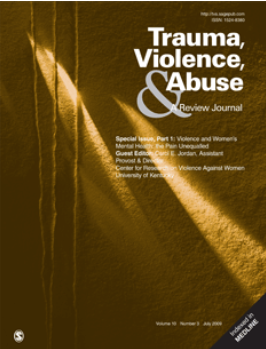打破沉默:在心理健康机构中解决家庭虐待问题--识别、筛查和应对
IF 5.4
1区 社会学
Q1 CRIMINOLOGY & PENOLOGY
引用次数: 0
摘要
遭受家庭虐待(DA)的个人很难透露自己的受害情况,但作为心理健康服务的频繁使用者,心理健康服务是识别和解决家庭虐待问题的关键场所。本系统性综述包含 20 项研究,调查了心理健康环境中的家庭暴力识别、筛查和应对措施。我们使用这些纳入标准对三个数据库进行了检索:18 岁及以上接受心理健康服务的成年人,样本包括心理健康专业人员(或组合)。没有地域限制。所有研究均经过同行评审,并在 2000 年 1 月至 2023 年 12 月期间以英文发表。研究必须包括对(前)伴侣之间的伤残检测筛查和/或在精神健康环境中对披露的反应。研究结果显示,从直接筛查工具到对患者档案的回顾性分析,伤残检测筛查方法存在很大差异。专业人员报告了他们在识别家庭暴力方面遇到的障碍,包括对自己角色的不确定性、时间限制以及与服务使用者建立信任的重要性。尽管如此,许多人还是强调了例行询问 DA 的重要性。少数干预措施能有效提高专业人员应对伤残津贴的准备程度,但目前仍不清楚何种形式的培训最为有效。服务使用者报告称,在披露伤残津贴时会感到羞耻和害怕不被相信,但治疗参与和专业意识的增强会对他们有所帮助。研究缺乏多样性。总之,在开发良好实践以支持心理健康专业人员通过评估工具和培训来识别和应对心理障碍的能力方面,还有很大的发展空间。本文章由计算机程序翻译,如有差异,请以英文原文为准。
Breaking the Silence: Addressing Domestic Abuse in Mental Health Settings—Identification, Screening, and Responding
Individuals experiencing domestic abuse (DA) struggle to disclose victimization, but as frequent users of mental health services, this is a pivotal setting for identification and addressing DA. This systematic review of 20 studies investigates DA identification, screening, and responses within mental health settings. Three databases were searched using these inclusion criteria: adults aged 18 and older accessing mental health services, samples comprising mental health professionals (or combination). No geographical restrictions were applied. All studies were peer-reviewed and published in English between January 2000 and December 2023. Studies had to incorporate screening for DA between (ex-)partners and/or response to disclosure within mental health settings. The findings revealed considerable variation in DA screening methods from direct screening tools to retrospective analyses of patient files. Professionals report barriers in identifying DA, including uncertainty about their role, time constraints, and the importance of building trust with service users. Nonetheless, many highlight the importance of routinely asking about DA. A small number of interventions have been effective in enhancing professionals’ readiness to address DA, but it remains unclear what format of training is most effective. Service users report feelings of shame and fear of not being believed when disclosing DA, but are aided by therapeutic engagement and enhanced professional awareness. There is a lack of diverse inclusion in the research. In summary, there is considerable scope to develop good practice to support mental health professionals’ ability to identify and respond to DA across assessment tool and training, but also in understanding what facilitates service users to disclose.
求助全文
通过发布文献求助,成功后即可免费获取论文全文。
去求助
来源期刊

Trauma Violence & Abuse
Multiple-
CiteScore
13.60
自引率
7.80%
发文量
131
期刊介绍:
Trauma, Violence, & Abuse is devoted to organizing, synthesizing, and expanding knowledge on all force of trauma, abuse, and violence. This peer-reviewed journal is practitioner oriented and will publish only reviews of research, conceptual or theoretical articles, and law review articles. Trauma, Violence, & Abuse is dedicated to professionals and advanced students in clinical training who work with any form of trauma, abuse, and violence. It is intended to compile knowledge that clearly affects practice, policy, and research.
 求助内容:
求助内容: 应助结果提醒方式:
应助结果提醒方式:


